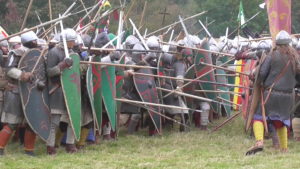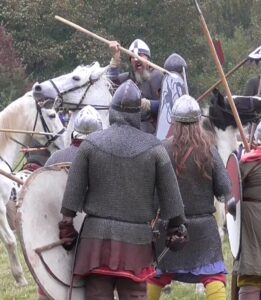
Before the Normans brought over their own version of feudalism, the Anglo-Saxons had a different way of calling up an army in need of defense. At the top of the scale were the Housecarls, the closest thing to a paid, standing army (or household troops) the leader could summon. They were loyal to their employer—the king or a great earl—and were usually composed of Danish or English professional soldiers. Some were landowners; it’s possible that some lived in barracks. When King Harold Godwineson unexpectedly had to go north to stop Harold Hardrada in September 1066, the Housecarls were the only warriors he could initially call upon.
Patterned after the Jomsvikings of Denmark (founded by King Harold, father of Swein Forkbeard), Housecarls are first mentioned in relation to King Canute—probably in 1018—and ceased to exist as an organization after the Battle of Hastings. It is believed they were in essence a military guild, with a body of regulations and the ability to call up a gemot or huskarlesteffne in the king’s presence to settle disputes or punish a transgressor.
Highly trained warriors, the Housecarls mostly fought on foot although it is more than possible that they were perfectly capable of fighting on horseback. Snorri Sturluson tells us in Heimskringla that Harold’s mounted troops attacked the disorganized Norwegians in the early phase of the Stamfordbridge battle. They would not have attacked head-on like we picture in the 14th century battles; rather they would veer past the enemy and launch javelins into their foes’ ranks, much like the Normans did at Hastings. Then they would dismount and finish the battle on foot. During the Battle of Hastings, Harold most likely spread out his Housecarls along the shield wall to support the less experienced fyrd; they were the only warriors that returned with him after Stamfordbridge, and by then their ranks had been sorely thinned. The Housecarls would have been a formidable sight; as seen in the Bayeux Tapestry, they could take down both rider and horse with one sweep of their awesome Danish axe. It was a testament to their—and the Anglo Saxon—valor that it took a whole day for William’s well-armed force to break their ranks.

Beneath the Housecarls, the fyrd was drawn from the general population of England. They responded to territorial obligations and were roughly divided into two categories, sometimes known as the select fyrd and the great fyrd. The select fyrd were usually better trained, and were generally composed of thegns, ceorls or upper peasantry. They were assigned on the basis of the 5-hide system throughout southern England (in the Danelaw, the land was assessed in carucates, but the same system is thought to be utilized). By the late Anglo-Saxon period, the hide was not a geographic unit of measure; in essence it was used to determine the amount of service owed to the king. I would theorize it had more to do with a density of population rather than its original definition (equivalent to the amount of land required to feed a peasant family). One lord’s manor could contain several 5-hide units, or perhaps several small estates would be stitched together to create one 5-hide unit. The bigger towns had the most hides even though they covered a small area. So for instance Cambridge was assessed at 100 hides; so was Colchester and Shrewsbury. Each would be obliged to produce 20 warriors.
The responsibility of the 5-hide unit was three-fold: military service, fortress work, and bridge repair. For their military obligation, each unit was required to produce one soldier and pay him for two months’ service (20 shillings) if called up by the king. This soldier was usually the same person whenever called up, so this is why he would probably be better trained and equipped than the ordinary fyrdman. Nonetheless, there was no annual training period for the select fyrd, and they were only called up in time of war; years could go by without going into service.
The most important distinction between the two categories of fyrd was that the select fyrd was expected to travel and serve for up to two months. The great fyrd, on the other hand, was called up for strictly local defense. The key difference is that the great fyrd must be able to return home at night; if the king required them to travel, he must pay them a wage. Because they were normally unpaid, they were not expected to come armed with much more than whatever came to hand: clubs, stones tied to sticks, farm utensils, etc. In many cases, they could very well supplement the better-armed select fyrd, which is perhaps what we saw at Hastings.
When taken as a whole, this system seems to have been very well organized. But it did not survive the Norman Conquest. Not all historians are in agreement about this distant era, and I used “Anglo-Saxon Military Instititions” by C.Warren Hollister as my primary source.